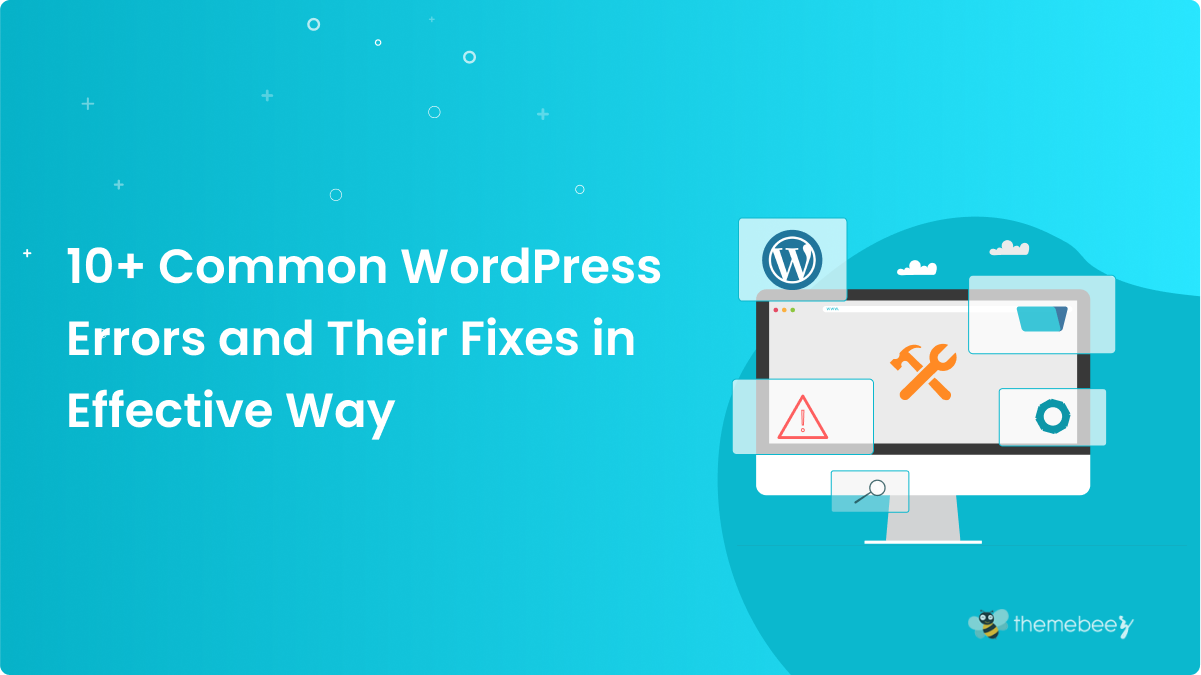WordPress is a popular and widely used content management system known for its user-friendly interface and robust features. However, WordPress encounters both minor inconveniences and major errors from time to time, which can be frustrating. Such errors can impact site performance, potentially harming reputation, credibility, conversion rates, and customer satisfaction.
So, having a good grasp of these common issues and their fixes can prepare you for future challenges and enable quick recovery.
In this blog post, we’ll have listed the most common WordPress errors and their fixes.
Table of Contents
Common WordPress Errors and Their Fixes
1. White Screen Of Death (WSOD)
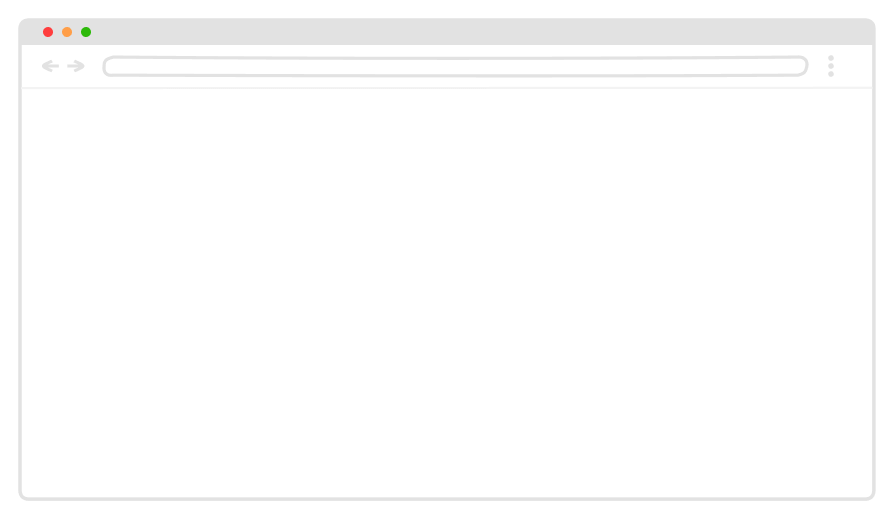
When you try to open your WordPress Website, a blank page appears instead of your website. It is called the White Screen of Death (WSOD). This issue provides no error messages or guidance, making it challenging to diagnose and resolve. The WSOD can occur for various reasons, indicating that your site could not load properly.
Possible causes:
- Faulty or incompatible plugins are the most common cause.
- Poorly coded or outdated themes can also lead to this issue.
- If your site exceeds its allocated memory limit, it can result in the WSOD.
- Mistakes in the code of your theme functions.php or other critical files can cause this problem.
Possible fixes:
- Disable plugins: Deactivate all plugins and reactivate them individually to find the issue.
- Disable the theme: Use SFTP to rename your active theme folder, reverting to a default theme.
- Activate debug mode: Add these lines to wp-config.php to enable the debug mode:
define('WP_DEBUG', true);define('WP_DEBUG_LOG', true);define('WP_DEBUG_DISPLAY', false);
- Purge your cache: Your website’s caching solution may display outdated files. Clear your cache to see if this resolves the problem.
- Increase PHP memory limit: Edit the wp-config.php file and add the line:
define ('WP_MEMORY_LIMIT','256M');. - Reinstall WordPress: Back up your site and reinstall WordPress if other methods fail.
2. Internal Server Error (500)
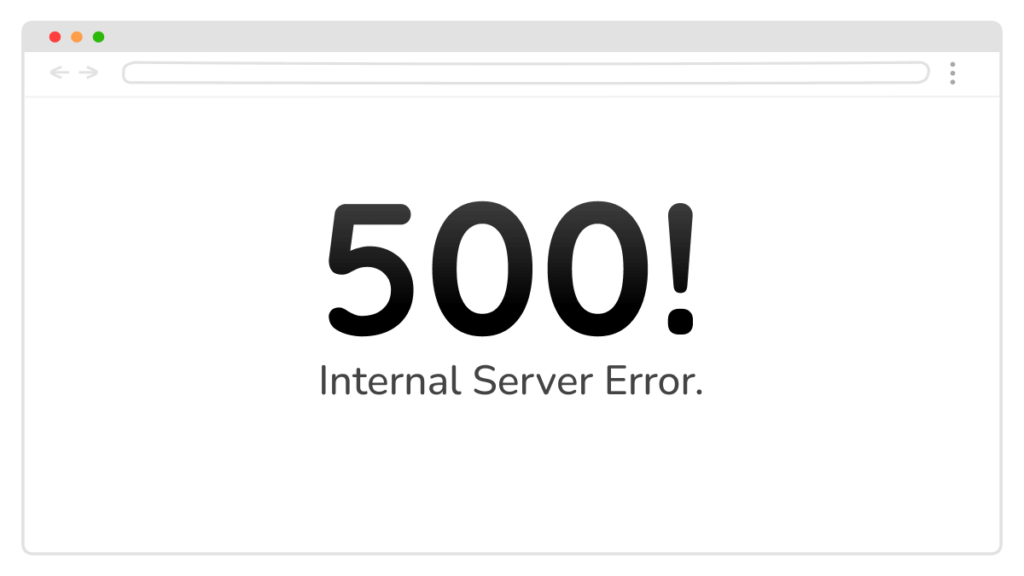
The 500 Internal Server Error is a common issue for WordPress users and website operators. It indicates a problem with the web server without specific details on what went wrong. Instead of a clear error message, you see HTTP 500 Internal Server Error, which can be confusing. Despite its vague nature, the cause is found quickly, and there are several ways to solve this.
Possible causes:
- Poorly coded or incompatible plugins and themes.
- Faulty PHP code in themes, plugins, or custom functions.
- Scripts require more memory than the server’s PHP limit.
- Incorrect or corrupted .htaccess configurations.
- Problems with server settings, permissions, or mod_security rules.
- Failed or incomplete WordPress updates.
Possible fixes:
- Fix corrupt .htaccess file:
- Rename .htaccess file to .htaccess_old.
- Refresh your site to generate a new .htaccess file via Permalink settings.
- Increase PHP memory:
- Enable
WP_DEBUGin wp-config.php withdefine('WP_DEBUG', true);. - Increase PHP memory limit in wp-config.php with
define('WP_MEMORY_LIMIT', '256M');.
- Enable
- Deactivate plugins and themes:
- Disable all plugins through the WordPress dashboard or FTP.
- Reactivate plugins one by one to pinpoint the issue.
- Switch to a default Twenty Twenty WordPress theme if needed.
- Check server configuration:
- Review server error logs for specific error messages.
- Contact the hosting provider regarding mod_security rules or PHP settings.
- Verify PHP version compatibility:
- Ensure your hosting environment supports the required PHP version.
3. Error Establishing a Database Connection
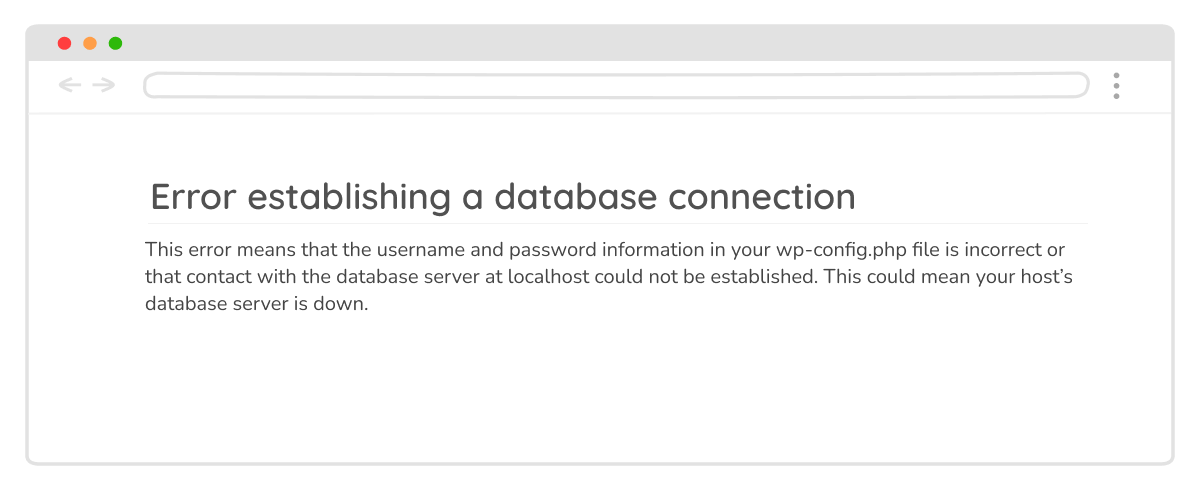
The Error Establishing Database Connection is a common issue in WordPress, particularly confusing for beginners. It occurs when WordPress cannot connect to the database storing the website content, settings, and user information.
Possible causes:
- Mistakes in database username, password, database name, or host details.
- Issues like server downtime or high traffic.
- Misconfigurations affect PHP memory limits or database connections.
- There are rare instances of database corruption due to incomplete updates or hardware issues.
Possible fixes:
- Verify database credentials: Double-check details in the wp-config.php file.
- Test database connection: Use tools like phpMyAdmin to ensure database server accessibility.
- Restart database server: Contact your hosting provider to check the server status or restart the database.
- Review server configuration: Adjust PHP memory limits and server settings as needed.
- Repair and optimize database: Use the WordPress repair tool by adding
define('WP_ALLOW_REPAIR', true);to wp-config.php, running the repair, and then removing the line after completion.
4. Error 404-Page Not Found
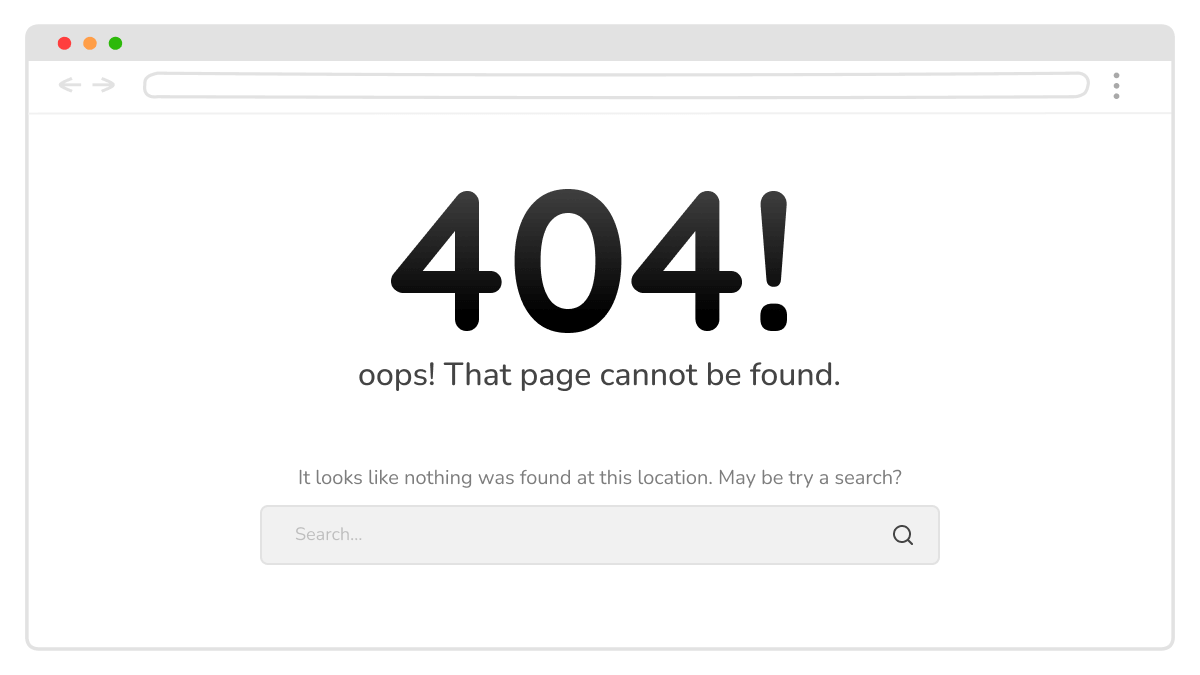
The 404 error, commonly known as “Page Not Found,” is a frequent issue encountered on WordPress websites. It occurs when a visitor attempts to access a page that does not exist or is unavailable on the server. This error message informs users that the requested page may have been deleted, moved, or never existed.
Possible causes:
- Incorrect URL structures or improperly configured permalinks can result in users encountering a 404 error.
- Accessing a page that has been removed causes a 404 error.
- Accessing a page URL that has been altered also causes a 404 error.
- Users may mistype a URL or follow a broken link from an external site, triggering a 404 error.
- Misconfigured .htaccess rules can misroute URLs and cause 404 errors.
Possible fixes:
- Check permalink settings: Refresh the permalink structure by navigating to Settings -> Permalinks in your WordPress dashboard and clicking “Save Changes.”
- Redirect deleted or moved pages: Use plugins like Redirection or Yoast SEO to set up 301 redirects from old URLs to new ones.
- Fix broken links: Use tools like Broken Link Checker to identify and correct broken links on your site.
- Create a custom 404 error page: Create a 404 error page that offers 404 error information and navigation options to help users return to your site’s content.
- Review .htaccess file: Check for misconfigurations in the .htaccess file and ensure it contains correct rewrite rules for your site’s URLs.
- Use redirect plugins: Use plugins such as Redirection, 301 Redirects, etc. to manage redirects efficiently and prevent 404 errors caused by structural changes.
5. Syntax Error
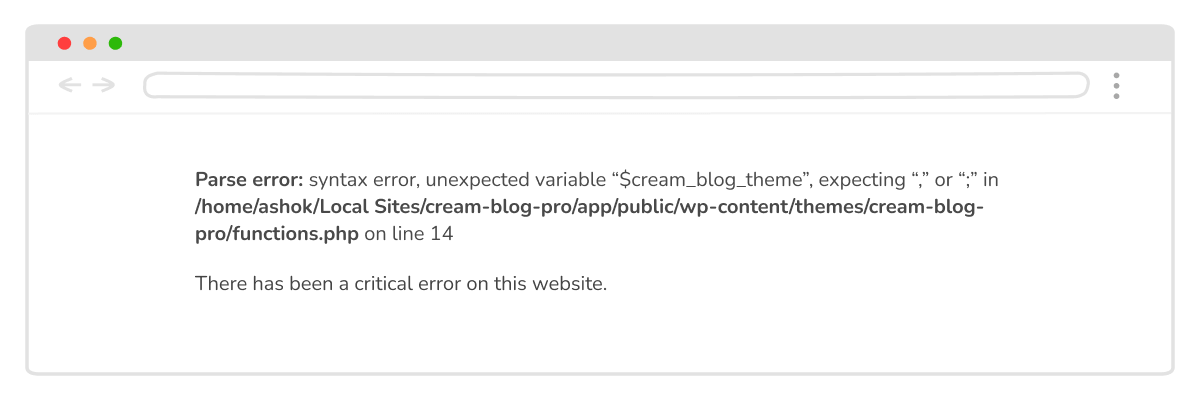
Syntax errors in WordPress refer to issues with the structure or punctuation of programming codes. These errors can range from simple typos to critical mistakes that prevent your site from functioning accurately. They often occur when adding code snippets from unreliable sources or making errors during manual code modifications.
Possible causes:
- Missing commas, semicolons, or parentheses can disrupt the code’s structure and cause syntax errors.
- Typos errors, such as misspelled function names or variables, can lead to syntax errors.
- Adding poorly formatted or incompatible code snippets, especially from online sources, can introduce syntax errors.
- Errors made while editing theme or plugin files directly from the editor can result in syntax errors.
Possible fixes:
- Identify the problematic code: Review the error message to identify the specific file and line of code causing the syntax error.
- Access the code: Use an FTP client like FileZilla to access your WordPress site’s backend.
- Locate and edit the file: Navigate to the directory where the affected file is located (e.g., the theme’s folder). Right-click on the file (e.g., functions.php) and choose “View/Edit.”
- Correct the error: Locate the line of code indicated by the error message and fix the syntax issue. Common fixes include adding missing punctuation or correcting typographical errors.
- Save and upload: Save the changes to the file and upload it to your server.
- Confirm the replacement of the existing file when your FTP client prompts it.
- Clear cache and test: Clear your browser cache and test your WordPress site to confirm the syntax error has been fixed.
6. Memory Exhausted Error

Memory limit errors on WordPress websites occur when the server exhausts the allocated memory. These errors often surface during activities like installing new plugins or uploading files. The error message typically reads Fatal error: Allowed memory size has been exhausted.
Possible causes:
- Your hosting plan allocates a specific amount of server memory. Exceeding this limit can trigger memory errors.
- Certain plugins or themes may require more memory than is available, leading to these errors.
- Your hosting plan might have server memory limitations that don’t meet your website’s needs. Check your hosting plan with your hosting provider for server memory.
Possible fixes:
- Increase PHP memory limit: Edit wp-config.php with
define('WP_MEMORY_LIMIT', '64M');to increase to 64MB. - Upgrade hosting plan: Consider higher-tier plans for more server resources if memory errors persist.
- Contact hosting provider: Seek provider assistance to raise memory limits or recommend suitable plans.
7. Connection Timed Out

A Connection Timed Out error occurs when a browser or user attempting to access a website fails to connect to the server within a specific time limit. This error indicates that the server took too long to respond to the client’s request, leading to the termination of the connection attempt. This error can be frustrating for users and website owners alike, as it prevents access to the site and disrupts the user experience.
Possible causes:
- Heavy server load or high traffic
- Slow server response times
- DNS resolution failures, connectivity issues, or firewall restrictions
- Resource-intensive plugins or themes
- PHP script execution time limits
- Distributed Denial of Service (DDoS) attacks
- Improper server, PHP, or WordPress configurations
Possible fixes:
- Check internet connection: Make sure your internet connection is stable and working. Test other websites to see if the issue is specific to your WordPress site.
- Consult hosting provider: Contact support for server or network issues.
- Increase PHP execution time: Adjust
max_execution_timein php.ini or .htaccess to 60 seconds. - Optimize website: Improve resource-intensive plugins/themes; use caching plugins.
- Deactivate plugins: Deactivate your website plugins, then reactivate them individually to find the problematic ones. Remove the problematic plugins and install suitable alternatives.
- Check for DDoS attacks: Use security plugins/services to detect and mitigate attacks.
- Review server configurations: Ensure correct server, PHP, and WordPress settings.
- Test with a different browser: Check if the issue is browser-specific.
- Use a CDN: Implement a Content Delivery Network to reduce latency and improve performance.
8. Failed Auto-Upgrade
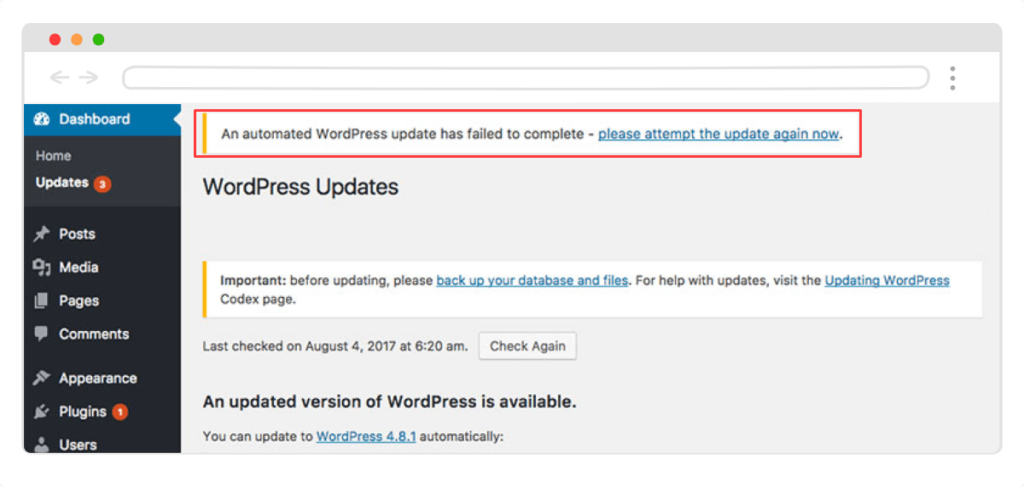
Automatic updates in WordPress are convenient for keeping your site up-to-date with the latest features and security fixes. However, they can occasionally fail, potentially causing disruptions in your website’s functionality. Automatic updates aim to simplify the maintenance of your WordPress site by ensuring it remains current with the latest software releases. However, these updates may encounter issues that prevent them from completing successfully.
Possible causes:
- Server settings/restrictions
- Connection interruptions during updates
- Incorrect file or directory permissions
- Incompatible themes/plugins with the latest WordPress version
- Low PHP memory limits
Possible fixes:
- Create a backup: Perform a full website backup, including files and database.
- Check server configuration: Review server settings; ensure updates are not blocked.
- Set correct file permissions: Adjust file and folder permissions (644 for files, 755 for directories) to allow file updates.
- Deactivate plugins & switch themes: Temporarily deactivate plugins and switch to a default theme to check for conflicts.
- Increase PHP memory limit: Boost PHP memory in wp-config.php with
define('WP_MEMORY_LIMIT', '256M');. - Manual upgrade: If auto-update fails, manually download and replace core files.
- Test again: Retry auto-update after adjustments to verify success.
- Enable debugging: Activate WordPress debugging for error insights if updates fail.
9. Briefly Unavailable for Scheduled Maintenance Error

When performing updates or maintenance tasks on your WordPress website, you might encounter an error message, Briefly unavailable for scheduled maintenance. Check back in a minute. This message indicates that WordPress has temporarily put your site into maintenance mode to ensure a smooth update process.
Possible causes:
- WordPress activates maintenance mode automatically during updates, especially for minor releases like security updates, to prevent disruptions.
- Updating WordPress core, plugins, or themes can also trigger maintenance mode for safety.
- WordPress may fail to exit maintenance mode properly if an update fails due to interrupted connections or incompatible files.
Possible fixes:
- Clear browser cache: Clear browser cache and cookies to eliminate cached maintenance mode messages.
- Delete .maintenance file: To exit maintenance mode via FTP or file manager, locate and delete .maintenance in your WordPress root directory.
- Check file permissions: Ensure correct permissions (755 for directories, 644 for files) to prevent update interference.
- Disable maintenance mode manually: If .maintenance deletion fails, add
define( 'WP_MAINTENANCE', false );to wp-config.php. - Verify plugins and themes: Temporarily deactivate plugins, switch to the default WordPress theme, and check for conflicts causing maintenance mode.
- Review failed updates: Investigate specific update issues; revert or manually update plugins/themes if necessary.
10. Image Upload Issues
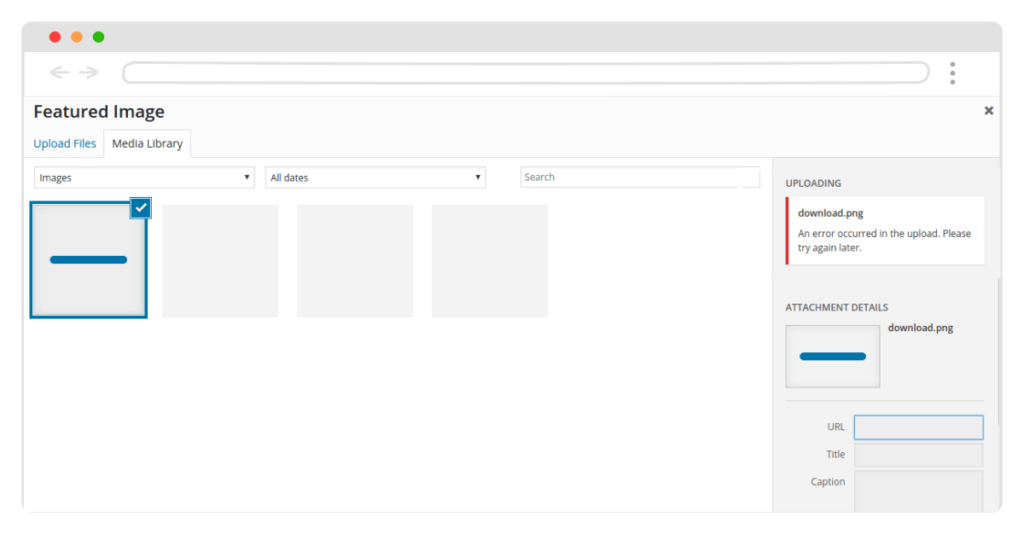
Encountering difficulties while uploading images to the WordPress Media Library can disrupt your website’s functionality and content management.
Possible causes:
- Improper permissions set for the uploads directory or its subdirectories can prevent WordPress from storing new files properly.
- If the maximum upload file size limit defined in your server php.ini file is too low, it can restrict the upload of larger files.
- These vague error messages may appear for various reasons such as expired login sessions, disallowed characters in file names, incorrect permissions, or server-side issues.
Possible fixes:
- Set correct file permissions:
- Navigate to your website directory using an FTP client (e.g., FileZilla).
- Locate the /wp-content/uploads/ directory.
- Right-click on it and select File Permissions.
- Change the permissions to 755. Ensure option “Recurse into subdirectories” is checked and apply the directory permissions.
- Increase file size limits:
- Edit your server php.ini file (or use a custom php.ini if supported by your host).
- Increase values for
upload_max_filesizeandpost_max_sizeto allow larger file uploads. For example:upload_max_filesize = 32Mpost_max_size = 32M
- Resolve HTTP error messages:
- Start by refreshing the page and attempting the upload again.
- If the problem persists, resize or rename your media files, ensuring file names contain only allowed characters.
- To identify conflicts, temporarily deactivate your plugins and switch to a default WordPress theme.
- Contact your hosting provider if issues persist, as server-side configurations or restrictions may require adjustment.
11. RSS Feed Errors
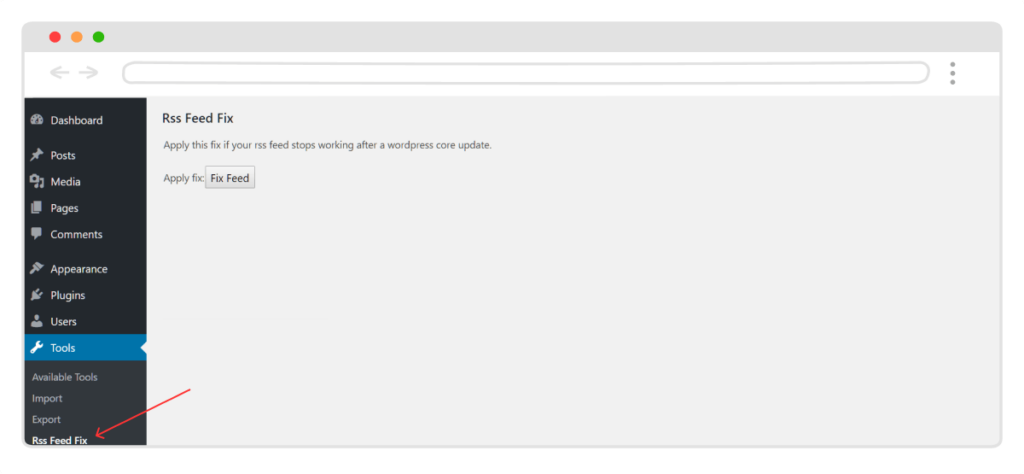
RSS (Really Simple Syndication) feeds are a vital feature for WordPress sites, enabling users to subscribe to your blog and access your content through various apps and services. However, when RSS feed errors occur, it can disrupt this functionality, leading to a poor user experience and potential loss of subscribers. These errors are often caused by formatting issues in the XML markup language used for RSS feeds, plugin conflicts, or theme issues.
Possible causes:
- Extra spaces, line breaks, or incorrect code in your theme’s functions.php file or other code snippets can disrupt the proper functioning of your RSS feed.
- Plugins that modify or create RSS feeds might conflict with your theme or other plugins, leading to errors.
- Custom or improperly coded themes can introduce errors in the RSS feed.
Possible fixes:
- Manually fix formatting:
- Review your theme’s functions.php file or any custom code snippets for formatting issues.
- Eliminate unnecessary spaces or line breaks following the closing PHP tag (?>).
- Consider using a plugin like WPCode to add code snippets in the future to avoid such issues.
- Disable RSS feed plugins:
- Temporarily deactivate any plugins that modify or create RSS feeds to see if the error persists.
- Reactivate the plugins individually to pinpoint the one causing the issue.
- Contact the plugin’s support for an update or find an alternative plugin if necessary.
- Switch to a default theme:
- Switch to a defaul Twenty Twenty WordPress theme to see if the error is related to your current theme.
- If the error disappears, contact the theme author for support or switch to a different theme.
- Validate your feed:
- Use an RSS feed validator to check the feed’s validity and identify any errors to be corrected.
- Check for plugin and theme incompatibilities:
- Deactivate all plugins and switch to the default theme to see if the RSS feed error gets fixed.
- Reactivate each plugin and theme one by one to identify the source of the conflict.
Conclusion
We hope this article helped you in resolving common WordPress errors effectively. If you found our tips helpful or have experienced any issues discussed, please share your thoughts and experiences in the comments below.
You might also be interested in the following article:
- Must-Have WordPress Plugins
- Adding Google Analytics to WordPress site
- Installing SSL Certificate on WordPress site
Thank you for reading till the end.
